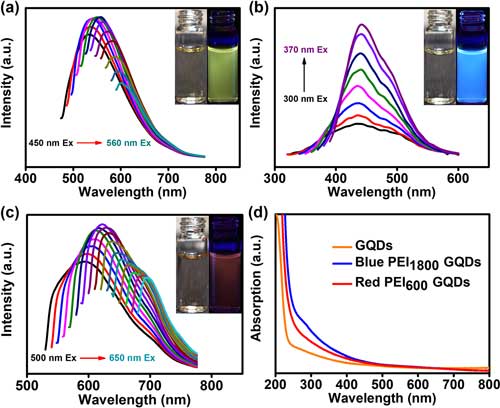| Posted: Jul 15, 2017 | |
Researchers develop blue-, yellow-, and red-emitting graphene quantum dots(Nanowerk News) Graphene quantum dots (GQDs) show great potential in the fields of photoelectronics, photovoltaics, biosensing, and bioimaging owing to their unique photoluminescence (PL) properties, including excellent biocompatibility, low toxicity, and high stability against photobleaching and photoblinking. |
|
| However, further development of GQDs is limited by their synthetic methodology and unclear PL mechanism. Therefore, it is urgent to find efficient and universal methods for the synthesis of GQDs with high stability, controllable surface properties, and tunable PL emission wavelength. | |
| In new work reported in ACS Applied Materials & Interfaces ("Red, Yellow, and Blue Luminescence by Graphene Quantum Dots: Syntheses, Mechanism, and Cellular Imaging"), researchers in China have synthesized PL-tunable GQDs with blue, yellow, and red emission colors by coating with polyethyleneimine (PEI) of different molecular weights. | |
 |
|
| PL spectra of GQDs (a), PEI1800 GQDs (b), and PEI600 GQDs (c) at different excitation wavelengths. Inset: photograph of aqueous solution of these three GQDs under room light (left) and 365 nm UV irradiation lamp (right). UV-vis absorption spectra (d) of GQDs, PEI1800 GQDs, and PEI600 GQDs dispersed in water. (© ACS) (click on image to enlarge) | |
| The team employed TEM, AFM, XRD, FTIR, XPS, DLS, and zeta potential to characterize the structures of the as-prepared GQDs and they stufied the PL mechanism by theoretical calculations. | |
| The average sizes of uncoated yellow-emitting GQDs, blue-emitting PEI1800 GQDs, and red-emitting PEI600 GQDs were 2.37, 6.05, and 57.31 nm, respectively. The yellow-emitting and blue-emitting GQDs were monolayer structures, whereas the red-emitting GQDs were multilayer structures. The red-emitting GQDs possessed a big PEI cage with multiple GQDs inside, whereas the blue-emitting PEI-coated GQDs had a single GQD core. | |
| The scientists found that carboxyl groups were changed to amide groups on the surface of GQDs and that this amidation reaction was crucial for PL change. By analyzing the molecular orbital and charge density, it was found that amide bonds decreased the conjugation and increased the energy gap thus inducing the blue shift of the PL. | |
| For the red-emitting GQDs, the conjugation area was enlarged by the interaction of GQDs in the PEI cage; thus, the PL peak exhibited a red shift. | |
| Remarkably, as the team points out, all GQDs exhibited good stability at high ionic strength and resisted photobleaching. Cell viability after treatment with the as-prepared GQDs indicated that GQDs had quite low cytotoxicity. | |
| "The GQDs could be used for bioimaging and are expected to be widely applied in multicolor imaging and bioanalysis applications," the authors cocnlude their report. "We hope that this work will inspire the design of even better GQDs with tunable PL properties." |
 By
Michael
Berger
– Michael is author of three books by the Royal Society of Chemistry:
Nano-Society: Pushing the Boundaries of Technology,
Nanotechnology: The Future is Tiny, and
Nanoengineering: The Skills and Tools Making Technology Invisible
Copyright ©
Nanowerk LLC
By
Michael
Berger
– Michael is author of three books by the Royal Society of Chemistry:
Nano-Society: Pushing the Boundaries of Technology,
Nanotechnology: The Future is Tiny, and
Nanoengineering: The Skills and Tools Making Technology Invisible
Copyright ©
Nanowerk LLC
|
|
|
Subscribe to a free copy of one of our daily Nanowerk Newsletter Email Digests with a compilation of all of the day's news. |
